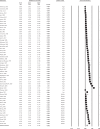Review Global seroprevalence of legionellosis - a systematic review and meta-analysis
- PMID: 32355282
- PMCID: PMC7193644
- DOI: 10.1038/s41598-020-63740-y
Review Global seroprevalence of legionellosis - a systematic review and meta-analysis
Abstract
Legionella is a ubiquitous pathogen yet the global occurrence of legionellosis is poorly understood. To address this deficit, this paper summarises the available evidence on the seroprevalence of Legionella antibodies and explores factors that may influence seroprevalence estimates. Through a systematic review, a total of 3979 studies were identified with seroprevalence results published after 1 January 1990. We tabulated findings by World Health Organization (WHO) region, location, study period and design, composition of study population(s) for all ages in terms of exposure, sex, detection methods, IFA titre, Legionella species measured, and present seroprevalence point estimates and 95% confidence intervals. Sampled populations were classified according to income, WHO region, gender, age, occupation and publication date. We conducted a meta-analysis on these subgroups using Comprehensive Meta-Analysis 3.0 software. Heterogeneity across studies was evaluated by the Q test in conjunction with I2 statistics. Publication bias was evaluated via funnel plot and Egger's test. Fifty-seven studies met our inclusion criteria, giving an overall estimate of seroprevalence for Legionella of 13.7% (95% CI 11.3-16.5), but with substantial heterogeneity across studies.
Conflict of interest statement
The authors declare no competing interests.
Figures




References
-
- Euzeby J. List of prokaryotic names with standing in nomenclature—genus Legionella. http://www.bacterio.net/legionella.html (1997).
Publication types
MeSH terms
LinkOut - more resources
Full Text Sources
Miscellaneous

